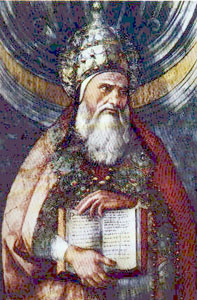
Pope Miltiades, also known as Melchiades the African, was the bishop of Rome from 311 to his death on 10 or 11 January 314. It was during his pontificate that Emperor Constantine the Great issued the Edict of Milan (313), giving Christianity legal status within the Roman Empire. The pope also received the palace of Empress Fausta where the Lateran Palace, the papal seat and residence of the papal administration, would be built. At the Lateran Council, during the schism with the Church of Carthage, Miltiades condemned the rebaptism of apostatised bishops and priests, a teaching of Donatus Magnus.

Pius I was the bishop of Rome from c. 140 to his death c. 154, according to the Annuario Pontificio. His dates are listed as 142 or 146 to 157 or 161, respectively. He is considered to have opposed both the Valentinians and Gnostics during his papacy. He is considered a saint by the Catholic Church with a feast day in 11 July, but it is unclear if he died as a martyr.

Pope Sylvester I was the bishop of Rome from 31 January 314 until his death on 31 December 335. He filled the See of Rome at an important era in the history of the Western Church, though very little is known of his life.
The 310s decade ran from January 1, 310, to December 31, 319.
The 320s decade ran from January 1, 320, to December 31, 329.
The 330s decade ran from January 1, 330, to December 31, 339.
The 340s decade ran from January 1, 340, to December 31, 349.

Flavia Julia Helena, also known as Helena of Constantinople and in Christianity as Saint Helena, was an Augusta of the Roman Empire and mother of Emperor Constantine the Great. She was born in the lower classes traditionally in the city of Drepanon, Bithynia, in Asia Minor, which was renamed Helenopolis in her honor, although several locations have been proposed for her birthplace and origin.
An apostolic see is an episcopal see whose foundation is attributed to one or more of the apostles of Jesus or to one of their close associates. In Catholicism, the phrase "The Apostolic See" when capitalized refers specifically to the See of Rome.

The Feast of the Holy Cross, or Feast of the Cross, commemorates the cross used in the crucifixion of Jesus. In the Christian liturgical calendar, there are several different celebrations which honor and celebrate the cross used in the crucifixion. Unlike Good Friday, which is dedicated to the passion of Christ and the crucifixion, these feast days celebrate the Cross itself, as the sign of salvation. It is chiefly celebrated by Roman Catholics, Eastern Orthodox, Oriental Orthodox, Old Catholics, Lutherans and Anglicans, and to a lesser extent by Presbyterians, Methodists and Baptists. The most common day of commemoration is September 14th for Churches that use the Gregorian calendar and September 27th for Churches that use the Julian calendar, Ge'ez calendar, or Coptic calendar.

April 25 - Eastern Orthodox liturgical calendar - April 27

July 28 - Eastern Orthodox Church calendar - July 30

During the reign of the Roman emperor Constantine the Great (306–337 AD), Christianity began to transition to the dominant religion of the Roman Empire. Historians remain uncertain about Constantine's reasons for favoring Christianity, and theologians and historians have often argued about which form of early Christianity he subscribed to. There is no consensus among scholars as to whether he adopted his mother Helena's Christianity in his youth, or, as claimed by Eusebius of Caesarea, encouraged her to convert to the faith he had adopted.

November 20 - Eastern Orthodox liturgical calendar - November 22

February 16 - Eastern Orthodox liturgical calendar - February 18
This is a timeline of the presence of Eastern Orthodoxy in Greece from 33 to 717 AD. The history of Greece traditionally encompasses the study of the Greek people, the areas they ruled historically, as well as the territory now composing the modern state of Greece.

December 3 - Eastern Orthodox liturgical calendar - December 5

December 25 – Eastern Orthodox liturgical calendar – December 27

The Martyrs of Persia under Shapur II were Christian martyrs who were put to death by Shapur II of Persia for failing to renounce their faith. Historical accounts suggest that approximately 16,000 Christians may have been martyred during this period. They are remembered collectively in the Roman and Orthodox calendars, with the Roman Martyrology listing feast days on April 6, April 22, and May 9 for different groups of martyrs.

This article lists historical events that occurred between 301–400 in modern-day Lebanon or regarding its people.










